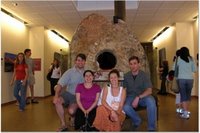
Four former Yap State Peace Corps Volunteer met in Washington DC this last weekend for a small reunion. The RPCVS, two who served in Yap Proper and two from the Outer Islands, enjoyed the opportunity to recount stories from their time in Micronesia, and discussed how to sustain their support through Habele. The former volunteers also had the chance to meet informally with the Micronesian Ambassador to the United States, the Honorable Jesse B. Marehalau, himself a native of the Ulithi Atoll.
In other Habele News, the fund has received its employer identification number from the US Department of the Treasury, and has established a bank account with contributions from the founding board members. Supporters are encouraged to make checks out to “Habele Outer Island Education Fund” and mail them to “Habele, 701 Gervais Street, Suite 150-244, Columbia SC 29201.”
‘Sa Chig!









